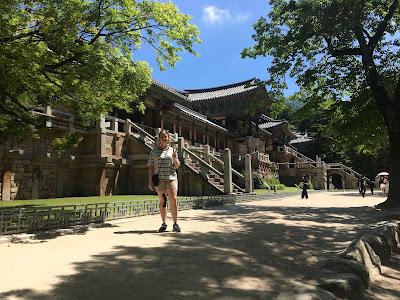After we filled our stomachs with naengmyeon and copious amounts of ice water, it was time for us to embark on our walking tour of the historic areas downtown, which were all conveniently connected to one another.
Our first stop was Tumuli Park (Daereungwon Tomb Complex 대릉원 - 천마총) which contains more than 20 tombs, many of which are the burial sites of the ancient kings, queens, and officials of the Silla Period. One of the tombs, Cheonmachong or the Heavenly Horse Tomb, you can even enter inside. Unfortunately it was closed for renovation during our visit. Now, there is supposed to be an entrance fee into the park, but we never came across one. The front gates were open and people were freely entering, so... we just went in? The park was a very surreal place to be, as people strolled around the giant burial mounds and had a nice day in the park. The fact that we were walking casually through an ancient burial ground was astounding to me. Imagining what it must've been like back then exercised my imagination. Just the thought of it filled me with wonder. The tombs tower above you, smoothly shaped and a vibrant green, filling you with a sense of their significance. The tombs are occasionally opened for archaeological purposes, and many ancient artifacts have been recovered such pottery, warrior and horse armor, jewelry, jade, crystal, ancient royal crowns, and much more. Many of the artifacts are displayed now at the Gyeongju Museum nearby, which we visited later that day.
The above video was taken from a display at the Gyeongju Museum, and shows how one of the tomb structures was built. All of the tombs were built in a similar manner, but there are subtle differences in some of the structures depending on who it was for and whether it was a single or double (King and Queen) tomb.
Walking along, the tombs gradually come to an end, and here you will find Cheomseongdae Observatory (첨성대). Known to be the oldest astronomical observatory in East Asia, it was built during the Silla period between 632-647. It was used to determine the weather and observe the stars, equinoxes, and solstices. The square hole seen just over half way up the structure is actually the entrance (you would need to hang a ladder from it) and an observer could from there ascend to the top. Overall there are 27 levels of stone, and 362 stones total (one for each day in the lunar year). It is an impressive structure.
After visiting the observatory tower, we headed to the Gyeongju National Museum. It was a welcome escape from the heat and humidity, with blasts of freezing air welcoming you the moment the doors swung open. The museum included several buildings and the array of artifacts that were found in the area was quite comprehensive. Among the items found were many works of pottery, numerous lotus roof tiles, earrings, jade, necklaces, belt loops, royal crowns and accessories, figurines and Buddha statues, as well as many other objects. Honestly the amount of artifacts that have been recovered is quite large. Its impressive. However, I didn't photograph inside the museum itself.
Finally, our last stop for the day were the remnants of Donggung Palace and Wolji Pond. 'Wolji' means 'a pond that reflects the moon'. The area surrounding the palace was very beautiful, with lotus flowers in pink and white blooming everywhere. Getting a close up photo without getting wet was difficult.
Most of the palace itself has long been gone, but the pond, which is man made, still holds on. Here you can see a few of the remaining buildings bordering the pond, as well as some of the artifacts that were retrieved from it. There have been hundreds to thousands of items retrieved from the pond including everything from common daily items to items more attributed to the royalty that once lived there. Even the remnants of an old pleasure boat were found at the bottom of the pond. I can just imagine potential Silla royalty taking a relaxing paddle around the pond many years ago. It is so awesome to think about. The night view here is stunning, and we saw many people setting up early to get the best photos once the sun set. We wanted to stick around to see what the area looked like once the lights came on after dark, but we were far too tired to stay. So, I settled to get my photos at dusk and I am still pleased with how they turned out.
Overall we only saw a fraction of what Gyeongju has to offer in terms of historical sites. There are many more palaces, pagodas, temples, and other sites to see. If we would've had time, I would've liked to have hiked Namsan Mountain. Considered the sacred mountain of Silla, there are 100 temples, 80 stone carved Buddhas and 60 pagodas scattering the mountain slopes and lining the mountain itself. There are also several royal tombs located along the bottom of the mountain. It sure would've been a sight to behold.
I also would've liked to try the Gyeongju bread, which must be famous considering how many stores were selling it all over the place. My intent was to pick some up and try it Sunday morning before departing, but I ended up not having the time.
Gyeongju truly lives up to its reputation as a museum without walls. It is a fascinating place. I wouldn't have minded living there (except maybe for the fact that it was SO hot).






























